|
Marketing Agency of the Month
Developing, nurturing and retaining relationships
Texas agency uses multifarious techniques to reach its common goal
By Dennis H. Pillsbury
“There’s more than one way to skin a cat and I happen to know that from experience,” the mayor of Sunnydale says in an episode of “Buffy the Vampire Slayer.”
And there’s also more than one way to achieve success in the independent agency system, as Rough Notes magazine has shown for the past 20-plus years of featuring successful agencies on our magazine cover. Brady, Chapman, Holland & Associates, Inc. (BCH), Houston, Texas, has taken that a step further by showing that there are many ways within an agency to reach for greatness.
Jeff Brady, president and CEO of the agency, notes that with the help of their employees, BCH reached a consensus on one principle that set the agency apart from the competition. “We had all just read the book Good to Great and were looking for our ‘hedgehog,’ which we coined our Diamond Principle. We wanted to bring clarity to what it was about this business that brought it to life for all of us.
“What was it that we were passionate about?” Jeff continues. “After discussing several ideas, we all realized that we were circling around one central theme: We were passionate at developing, retaining and nurturing relationships. And that includes all our relationships. Those we have with each other, with our clients, with our companies, and with our community.
“Once BCH established this first guiding principle, we set up criteria for our people to be recognized for their adherence to the Diamond Principle. Whenever someone goes that extra mile for another employee or a client or a company representative or a community organization, we put a ‘diamond’ in a jar. Once the jar is full, we have a celebration. It’s something that everyone enjoys and everyone has a chance to be part of the winning effort,” Jeff notes.
“In fact, the staff drove the effort for us to be recognized as one of the best places to work in Houston,” he continues. “We’re really very proud of that, not just because of the recognition, but because it shows how involved people are and how much they like working here. And that’s reflected in the way they treat clients and each other. We’ve managed to create a positive environment that keeps perpetuating itself and growing exponentially.”
The one-hour retirement
Jeff took over the agency’s reins seven years ago when his father, Tim Brady, “retired” at the age of 65. “I had no interest in retiring,” Tim admits, “and Jeff recognized that he needed to find something for me to do.”
Jeff quips: “We didn’t even have time to put together a party. I didn’t want to lose Dad’s enthusiasm and expertise and he didn’t want to stop working. I suggested that he become our sales coach and he jumped at the opportunity.”
Tim co-founded the agency in 1983 with Ed Chapman and Lonnie Holland. He had been working for the Nordstrom Group, which was based in Minneapolis. When the firm left Texas, he bought their Houston office and a year later, he and his partners formed the agency. Today, the agency has 75 people accounting for about $13.5 million in revenue.
“It’s been an interesting ride,” Tim admits. “When we started the agency, it was small enough that we could manage by the seat of our pants. Today, however, we’re too big for that. When Jeff took over, he formed an operations committee that includes myself; the coach of carrier relations and marketing; the coach of commercial lines; the coach of employee benefits, financial services and our liaison to our personal lines agency; the coach of administration and our controller (who is also my daughter); and the coach of IT/business process development. It gives him a person responsible in each of the critical areas for the agency—someone he can rely on when problems or questions arise. The committee meets monthly to make certain we are in synch with our plans for future growth.”
Focusing on strengths
“Our primary niche focus is construction and construction-related firms,” Tim says. “That represents around 35% of our business. Another important niche is habitational/association risks, where we insure a number of property management firms. Our third core strength is in the manufacturing and distribution area. Outside of those areas, we are pretty much a generalist; however, we have begun to look at other niche areas where we believe we can be successful as we add new producers to the firm and teach them the ‘set offense’ approach to sales. These include health care and oil and gas.
“As you can see, personal lines is not mentioned. That’s because about 10 years ago, we recognized that we just weren’t very good at growing personal lines. So we formed a new agency, Focus Insurance and Financial Services, which we jointly own with a friendly competitor, to handle all the personal lines business. We moved all our personal lines business there and since that time, it has continued to grow and is doing very well. In fact, we are making more money on personal insurance than we were when we were doing it ourselves.” Focus Insurance and Financial Services operates independently and services all of BCH’s personal insurance clients.
The set offense
Tim says, “When I became the sales coach, allowing us to focus on growing our production side of the business, the first thing we did was institute a program for bringing new ‘consultants’ into the firm. Our producers are called consultants because that really is their focus. They are expected to provide a consultative approach to risk management that includes insurance as only a part of the solution for our clients.
“The next thing we did was look for help,” Tim admits. “We went to Roger Sitkins and he’s been our mentor ever since. We follow his lead very closely and adjust based on our culture. We use the set offense, a risk reduction approach to sales, and it has worked exceedingly well. Whenever our consultants use this approach, our closing ratio is 83%.
“The set offense basically involves a consultative approach,” Tim continues. “The consultant learns how to identify and implement risk reducing strategies that will positively impact our clients’ and prospects’ businesses. They use and practice with numerous tools we have developed over the past few years to obtain and retain ideal clients.
“In addition, we also have our new consultants go out with me and our seasoned consultants to see how it is done. For a while, they are attached at the hip with the senior partners. We’ve had quite a number of successes with this approach. Not every young consultant has worked out, but we’ve had more pluses than minuses.”
Not everybody buys in
You’d think that an 83% closing ratio would convince everyone that the set offense is the best approach, but not so. “Some of the older consultants resisted,” Tim says, admitting that it is funny for a man of 72 to be frustrated by the vagaries of the ‘old’ consultants. “They wanted to continue to do it their way,” Tim says, “and they had large books of business so we finally came to an understanding. I went to them and said, ‘Look, I’m frustrated and you’re frustrated. Let’s just agree to differ. As long as you don’t interfere with the new approach and don’t do things that waste resources, you can do it your way.’
“Out of that grew the Senior Tour and the PGA (Producers Growing through Accountability) Tour. It’s worked out great. The younger consultants are bringing in a lot of new business and are getting ready to move in and retain the business that the older consultants currently control. And, because the frustration has been removed, the Senior Tour has been great at working with the PGA.”
The agency currently has 12 shareholders, with Jeff being the largest, followed by the other remaining founding partner, Ed Chapman. Ed will soon be diluting his holdings under the rule that requires shareholders to begin selling based on age and stock holdings so that they own no more than 2% of the outstanding stock by age 72. The agency also has an ESOP which owns about 13% of the stock.
New business is key
The lengthy soft market and economic downturn through which all agents are suffering has made it clear that new business is the key to growth. “We are focused on retaining and obtaining ideal clients,” Tim says. “We want clients who share our focus on risk management and are willing to make a long-term commitment to that goal. Once we have that client, we want to earn and serve all of their risk management needs.
“In our strategy meetings with our consultants, we emphasize the need for cross-selling,” Tim continues. “Every consultant should see himself as the owner of a 50-table restaurant with each table representing a client. They need to have people at every table and people in every seat at each table. Each table should have as many areas represented as applicable—P-C, benefits, financial services, PEO/HR, personal insurance, bonding and/or our fee for service safety/loss control services.
“The easiest new business to get is business from an already committed client. That’s what cross-selling is all about and that is where referrals come from.” Tim adds, “Plus the additional lines create additional exit barriers needed in retaining our accounts.”
Employees—“Our people make the difference”
“Another area where Good to Great helped us get to the next level was in the area of attracting and retaining the best team members,” Jeff adds. “Having the right people on the bus and in the right seat on the bus makes for a much happier, productive and client-focused team member. And while technical education is stressed, we have developed a wellness approach to employee benefits that we practice both internally and with our clients.”
Jeff adds, “We built an incentive program for our employees around wellness. For example, we subsidize weekly Weight Watchers meetings for employees and their families. When we first introduced the program, our employees and their families lost a total of almost 700 pounds in the initial enrollment period. We also help employees stop smoking and will entertain any programs that employees think we need to help them stay fit and better able to do their jobs.
“We also adopted flex time and work-at-home programs that, if you’ve ever seen the traffic in Houston, definitely qualify as wellness programs. Talk about lowering stress. There’s nothing better than missing rush hour.”
Good corporate citizens
About six years ago, BCH formed a Contributions Committee to coordinate the agency’s charitable work. Since that time, the agency has donated more than $100,000 to charity, and an equal amount has been donated by employees. At the same time, employees are also involved in giving time to charitable organizations. “Currently our folks are volunteering at over 10 different organizations including The MS Society, Make-A-Wish, Bridges to Community, Northwest Assistance Ministry, The Open Door Mission, Interfaith Ministries (Meals on Wheels), Child Advocates, Habitat for Humanity, KidsMeals and The Houston Area Women’s Shelter.
“We also have folks involved in chamber of commerce groups, Rotary Clubs and such,” Jeff points out. “In all, we have touched more than 60 groups with financial and or physical support.”
The agency also is involved with the insurance community. Tim is a past president of the Independent Insurance Agents of Texas (IIAT) and the Independent Insurance Agents of Houston (IIAH). Jeff and a coach are also past presidents of IIAH. In addition, the COO at BCH’s personal lines agency is the incoming president of IIAH, and one of the shareholders is in the chairs to follow as well. “We constantly have people involved in those organizations,” Jeff notes. “We firmly believe that it’s important to give back to the communities that have allowed us to grow and prosper in an industry that we enjoy and that allows us to help people manage their risks so they can grow and prosper in their chosen professions.”
Brady, Chapman, Holland & Associates, Inc., exemplifies the focus on doing the right thing that makes the independent agency system such a positive force in our economy. We at Rough Notes are proud to recognize the agency as our Marketing Agency of the Month.
|
|
| |
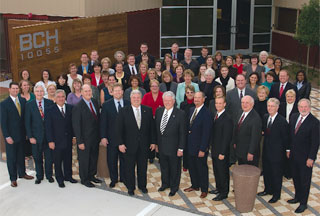 |
| |
The BCH Team. |
| |
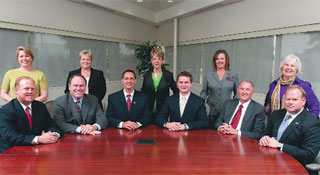 |
| |
BCH Risk Consultants and Account Executives. |
| |
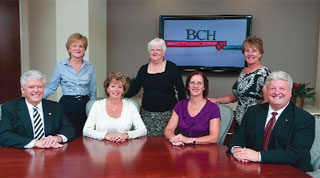 |
| |
The Operations Committee. |
| |
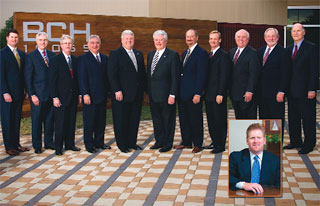 |
| |
In 2008, BCH had 11 shareholders (from left): Senior Vice Presidents Kevin Comiskey, CIC; Kelly Wayne Gerland, CIC; Paul R. Goan, CPCU; Ronald L. Wininger, CIC; President and CEO Jeffrey L. Brady, CIC, CRM; Chairman Timothy J. Brady; Executive Vice President Edwin W. Chapman, CPCU, CIC; and Senior Vice Presidents Mark R. Bauer, CIC; Mickey Youngblood, CIC; Charles E. Comiskey, CPCU, CIC, CPIA, CRM, CWCA, CRIS; and Michael Descant, CPCU. Senior Vice President Dennis M. Descant (inset) became the 12th shareholder in 2009. |
| |
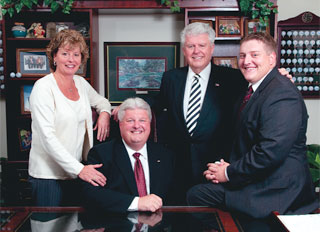 |
| |
Three generations of Bradys are part of the BCH Team. From left are two representatives of the second generation: Tim’s daughter, Jan Clark, Vice President and Controller, and Tim’s son Jeff Brady. Tim represents the founding generation; and his grandson and Jeff’s son, Timothy J. Brady, ARM, CRIS, CLCS, is a Risk Consultant. |
|